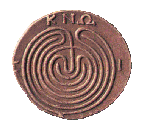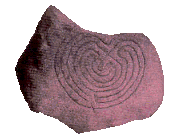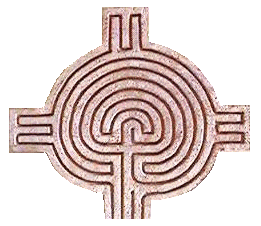My wife picked up a book at a garage sale entitled "Unsolved Mysteries of the Past" by Reader's Digest. One of the topics covered is the labyrinth. I really had never given much thought to a labyrinth and did not know that it was different from a maze. A maze contains dead ends and is designed to confuse and to puzzle. This simple book started me on a journey I feel I am just starting.
Labyrinth History
 The labyrinth is not a puzzle. It is a spiritual tool and symbol. There are no dead ends and there is only one path to follow, the course reverses itself over and over again in cycles. The Cretan coin to the right dates from second century B.C. from Knossos, Crete. This is an example of a seven cycle labyrinth.
The labyrinth is not a puzzle. It is a spiritual tool and symbol. There are no dead ends and there is only one path to follow, the course reverses itself over and over again in cycles. The Cretan coin to the right dates from second century B.C. from Knossos, Crete. This is an example of a seven cycle labyrinth.
 The Cretan coin however is not the earliest origin of this seventh cycle labyrinth. The Hollywood stone dates back to 1500 B.C. and was found near Hollywood, County Wicklow, Ireland.
The Cretan coin however is not the earliest origin of this seventh cycle labyrinth. The Hollywood stone dates back to 1500 B.C. and was found near Hollywood, County Wicklow, Ireland.
This is a Bronze Age rock carving in granite. The seven cycle labyrinth must have had a very special significance for these people to have carved it into granite without the use of iron chisels.
"The Hollywood Stone certainly would have been something of a feat to carve on granite without iron chisels - in fact it was certainly carved with an iron chisel and therefore cannot date to the Bronze Age. Its former location alongside an early Christian pilgrims track to Glendalough would strongly suggest that it is Christian in origin, probably somewhere between the 6th and 14th centuries CE, possibly towards the earlier end of that range."
Jeff Saward, editor Caerdroia.
It is significant that this design appeared in these two different geographic areas separated by 1,300 years. Identical labyrinths were also found in England and Scandanavia from the bronze age. This seventh cycle labyrinth is the Manas-Chakra emblem found in Rajasthan, India and the symbol of Mother Earth to the Hopi Tribe of Arizona.
Reference:
Unsolved Mysteries of the Past (Quest for the Unknown), Pleasantville, New York: The Reader's Digest Association, Inc., 1991.
Why the Labyrinth Cross
 That one page description and history of the seven cycle labyrinth stuck with me for months. I simply could not stop occasionally thinking about the design. One night I got the image of the labyrinth design incorporated into a cross.
That one page description and history of the seven cycle labyrinth stuck with me for months. I simply could not stop occasionally thinking about the design. One night I got the image of the labyrinth design incorporated into a cross.
The labyrinth cross became an obsession with me that kept me awake at night. It soon became apparent to me that the only way I was going to get any peace would be to produce the cross.
I have been working with clay for the last seven years and I figured it would be a simple task to form the cross and carve the design. The first carving went well but just didn't seem right. The second carving turned out a little bit better and I was starting to develop a good carving technique.
The third carving seemed fine. At this point I realized the carving would take a very long time to do. The best thing would be to make a mold of the carving so that I would not have to carve it ever again. I poured the plaster but . . . it never setup and crumbled.
 So on to carving number four. I decided to fire this carving in case there was a problem with the mold. That cross exploded in the kiln.
So on to carving number four. I decided to fire this carving in case there was a problem with the mold. That cross exploded in the kiln.
Finally the seventh carving produced a mold. I was seriously starting to wonder whether the cross was ever going to be made or if it all was simply a lesson.
The Labyrinth and The Cross
 The first thing to notice is the labyrinth starts from a small internal cross. This leads me to believe that the labyrinth may be a seal of the covenant of what was to come . . . The Messiah and the salvation of mankind. The outer cross represents the fulfillment of that covenant in the crucifixion and resurrection of Jesus Christ. I cannot really express the personal meaning of the labyrinth to me other than I know it was something I had to express in form.
The first thing to notice is the labyrinth starts from a small internal cross. This leads me to believe that the labyrinth may be a seal of the covenant of what was to come . . . The Messiah and the salvation of mankind. The outer cross represents the fulfillment of that covenant in the crucifixion and resurrection of Jesus Christ. I cannot really express the personal meaning of the labyrinth to me other than I know it was something I had to express in form.
One visitor to my house declared the cross to be of Celtic origin and then proceed to describe the "Mother Earth" symbol and the arms of the four directions embracing it in the four primary directions. He is of Scottish decent, but he quickly recognized the true meaning of a Hopi Native American symbol.
I think it is important that the labyrinth cross have a personal meaning and use to each individual.
Research and Opinions
If you know of any additional information or links relating to the seven cycle labyrinth, please drop me an e-mail. I would also be very interested in what the labyrinth cross means or symbolizes to you.
Sincerely,
John Kostura
E-Mail: jk@2near.com
Reference
- Dodge, Ellin.
Unsolved Mysteries of the Past (Quest for the Unknown), Pleasantville, New York: The Reader's Digest Association, Inc., 1991.
Links
John Kostura E-Mail: jk@2near.com



 The labyrinth is not a puzzle. It is a spiritual tool and symbol. There are no dead ends and there is only one path to follow, the course reverses itself over and over again in cycles. The Cretan coin to the right dates from second century B.C. from Knossos, Crete. This is an example of a seven cycle labyrinth.
The labyrinth is not a puzzle. It is a spiritual tool and symbol. There are no dead ends and there is only one path to follow, the course reverses itself over and over again in cycles. The Cretan coin to the right dates from second century B.C. from Knossos, Crete. This is an example of a seven cycle labyrinth.
 The Cretan coin however is not the earliest origin of this seventh cycle labyrinth. The Hollywood stone dates back to 1500 B.C. and was found near Hollywood, County Wicklow, Ireland.
The Cretan coin however is not the earliest origin of this seventh cycle labyrinth. The Hollywood stone dates back to 1500 B.C. and was found near Hollywood, County Wicklow, Ireland.
 That one page description and history of the seven cycle labyrinth stuck with me for months. I simply could not stop occasionally thinking about the design. One night I got the image of the labyrinth design incorporated into a cross.
That one page description and history of the seven cycle labyrinth stuck with me for months. I simply could not stop occasionally thinking about the design. One night I got the image of the labyrinth design incorporated into a cross.
 So on to carving number four. I decided to fire this carving in case there was a problem with the mold. That cross exploded in the kiln.
So on to carving number four. I decided to fire this carving in case there was a problem with the mold. That cross exploded in the kiln.
 The first thing to notice is the labyrinth starts from a small internal cross. This leads me to believe that the labyrinth may be a seal of the covenant of what was to come . . . The Messiah and the salvation of mankind. The outer cross represents the fulfillment of that covenant in the crucifixion and resurrection of Jesus Christ. I cannot really express the personal meaning of the labyrinth to me other than I know it was something I had to express in form.
The first thing to notice is the labyrinth starts from a small internal cross. This leads me to believe that the labyrinth may be a seal of the covenant of what was to come . . . The Messiah and the salvation of mankind. The outer cross represents the fulfillment of that covenant in the crucifixion and resurrection of Jesus Christ. I cannot really express the personal meaning of the labyrinth to me other than I know it was something I had to express in form.